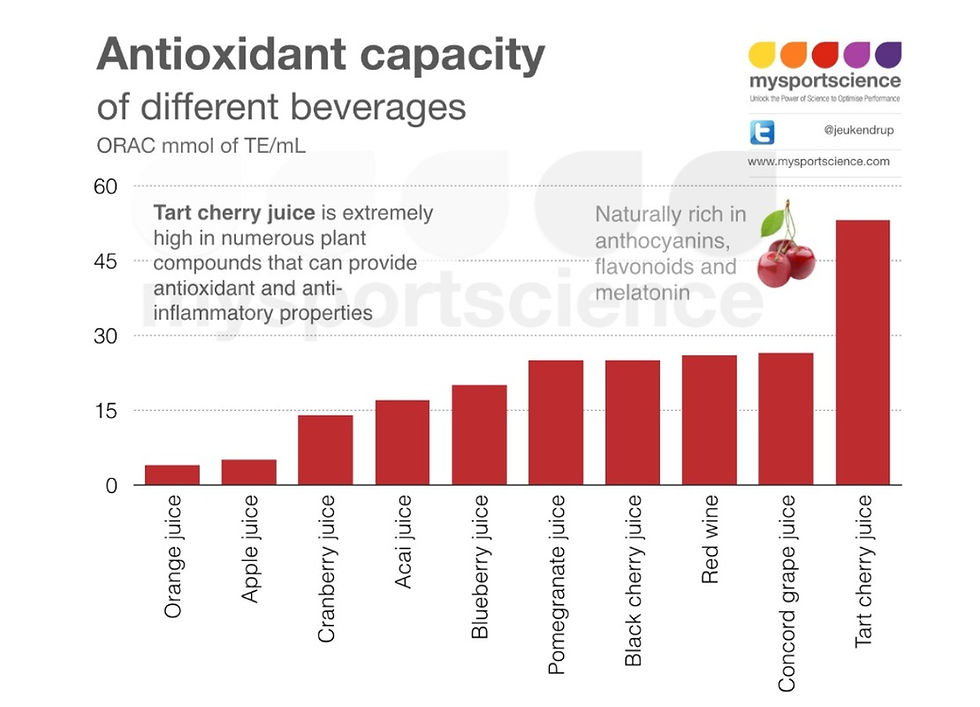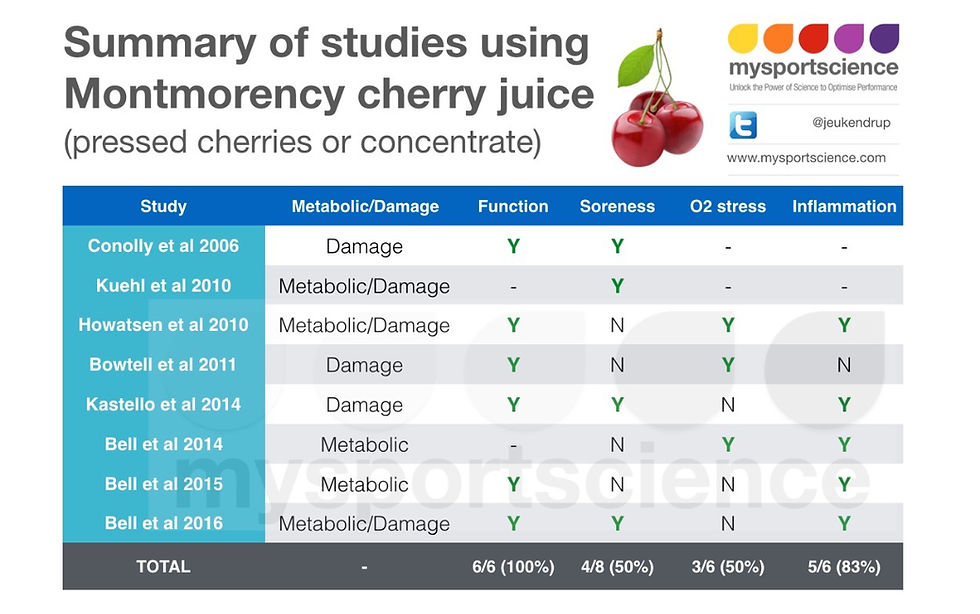Bitter-sweet application of Montmorency cherries in recovery
- Glyn Howatson
- Nov 5, 2016
- 4 min read
Updated: Oct 21, 2020
In recent years there has been a growing interest in so-called ‘functional foods’. One of these is tart cherry juice which is supposed to help recovery. Why do Montmorency cherries aid post-exercise recovery? How much should you have and when? Read on to find out...

Functional foods
In recent years there has been a growing interest in so-called ‘functional foods’. In broad terms these foods are proposed to have an additional benefits to human health beyond the caloric content; for example, some berries and cherries that are rich in dietary polyphenols have been show to improve vascular function. In some cases, these foods have been proposed to have medicinal benefits and their consumption amongst the global population is widespread, to the point where the world market is estimated to be in excess of $177 Billion. The appeal of foods with bioactive compounds is of great appeal since they offer the consumer a relatively risk free alternative to pharmacological or supplement interventions that might have unwanted side effects or be contaminated in some way. Understandably, these foods and their derivatives are of interest to recreational exercisers and athletes because of the potential ergogenic effect and ability to improve athletic recovery (1).
Montmorency cherries
There are many fruits and vegetables that the media are very quick to jump on and promote as the next wonder food; however there are few stories that have an evidence base to support what it says on the tin. A fruit that is emerging with a good deal of promise is tart Montmorency cherries. This specific cultivar of cherries is extremely high in numerous plant compounds that can provide antioxidant and anti-inflammatory properties and compares favorably with other fruit and tea beverages (Figure 1). The application of these fruits consumed whole, dried, as a juice or a concentrate are varied and numerous applications ranging from management of rheumatic conditions in humans to reducing inflammatory markers in a Petri dish to accelerating recovery following strenuous exercise. The latter of these, exercise recovery, is an area of huge importance for athletes, particularly when training schedules are frequent and competition schedules are congested.

Figure 1. A comparison of antioxidant capacity of fruit and tea beverages. (it has been questioned how valid this measure of antioxidant capacity is and therefore these results should not be over interpreted)
Montmorency cherries and recovery
The story of Montmorency cherries in exercise recovery started 10 years ago at the University of Vermont and the Nicholas Institute of Sports Medicine and Athletic Trauma with Declan Connolly and Malachy McHugh (2). They showed, in an isolated muscle-damage model, that Montmorency cherry juice accelerated the recovery of function and reduced muscle soreness when compared to a placebo beverage. Since then a number of studies from various labs across the UK and USA have shown a positive effect, in at least one variable, with Montmorency cherry juice (Figure 2, summary), which range from isolated eccentric-induced muscle damage to applied strenuous exercise models (Marathon running, cycling, repeated days exercise and team sports play).

Figure 2. Summary of studies
The previous research showed mixed result on inflammation, oxidative stress and muscle soreness, which is probably due to methodological differences such as exercise mode and intensity. However, the most important aspect, from an athletic performance perspective, is that muscle function is consistently accelerated in the days following the strenuous exercise.
These data have not gone unnoticed and Montmorency cherries are routinely used in recovery as an intervention by Olympic athletes, the NHL, the EPL, NCAA Division 1 football, professional road cycling, Premiership and International rugby, particularly in times of competition congestion.
How much and when?
Montmorency cherries are taken in a juice format; either a fresh pressed juice or most commonly in a concentrate, where 30 mls of the concentrate can be taken neat or diluted with 100-200 mls of water. Whilst the whole fruits are great to eat, each serving of juice and concentrate can offer between 60-90 cherries per serving (depending on product) and consequently offer a convenient of way to consume a good volume of the nutrients. Interestingly, all previous work has used a loading phase of several days, which means that you need to be well prepared before the strenuous exercise. However, this makes little sense because the primary plant compounds of interest, like polyphenols (including anthocyanins), that appear to be responsible for the positive effects are metabolised quickly and peak in blood 1-3 hours after consumption and subside to basal levels within ~8 hours. So conceptually, Montmorency cherries could be consumed twice a day following the strenuous exercise until the negative symptoms (function and soreness) have abated, without the need for a loading phase.
Sleep
Sleep is also a critical element of exercise recovery, which is not always easy to achieve when travelling regularly or when fatigued or suffering with sore muscles. There is evidence to show that melatonin is also contained in Montmorency cherries and can help to improve sleep efficiency (3), which is a good index of sleep quality. Consequently, taking the juice about 1 hour before bed could be an effective way to improve sleep and hence recovery from training and competition.
Summary
In summary, Montmorency cherries are a rich source of numerous plant compounds that can be beneficial in exercise recovery, particularly in times of high volume training and competition congestion. The juice can be utilized following both mechanically challenging (like heavy resistance training) or metabolically taxing, or concurrent exercise bouts that will likely result in reduced function and increased soreness. A concentrate offers a simple way to consume the polyphenol-rich fruit; and when taken close to bedtime could also facilitate better rest through sleep. However, make sure the correct variety of cherry is used – not all cherries are created equal and the evidence for a positive recovery response is ONLY evident with Montmorency tart cherries.
References
Bell, P.G. McHugh, M.P., Stevenson, E., and Howatson G. (2014). The role of cherries in exercise and health. Scandinavian Journal of Medicine and Science in Sports, 24, 477-490.
Connolly, D.A.J., McHugh, M.P., Padilla-Zakour, O.I. (2006). Efficacy of a tart cherry juice blend in preventing the symptoms of muscle damage. British Journal of Sports Medicine, 40,679-683.
Howatson, G., Bell, P.G., Tallent, J., Middleton, B., McHugh, M.P., Ellis, J. (2012). Effect of tart cherry juice (Prunus cerasus) on melatonin levels and enhanced sleep quality. European Journal of Nutrition, 51, 909-16.




















